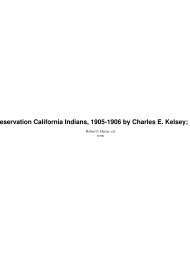[PDF] Old Horny, Yosemite's Unicorn Buck - Yosemite Online
[PDF] Old Horny, Yosemite's Unicorn Buck - Yosemite Online
[PDF] Old Horny, Yosemite's Unicorn Buck - Yosemite Online
Create successful ePaper yourself
Turn your PDF publications into a flip-book with our unique Google optimized e-Paper software.
YOSEMITENATURE NOTESFEBRUARY, 1932
<strong>Yosemite</strong> Nature NotesTHE PUBLICATION OFTHE YOSEMITE EDUCATIONAL DEPARTMENTAND THE YOSEMITE NATURAL- HISTOitY ASSOCIATIONPublished MonthlyVolume XI February 1932 Number 2The Thrill of Hunting With a CameraBy C. C. PRESNALL, Junior Park NaturalistHunting with a camera may be so tame that they will pose nicesoundtame, but it is far more thrill- ly for pictures, and then take theing and calls for much greater camera apart in their eagerness toskill than the old scatter-gun sport. see the result . That is during theTrue, a camera makes no noise, nor open season for tourists . When windoesit indicate hits or misses until ter comes, the bears go. Then theafter a session in the dark room, yet would-be photographer must bribeno one can question its pre-emi- the sleepy bruin with chicken bonesnence in sport after having seen and bacon rinds to persuade themsuch camera classics as those pro- to pose in the snow instead of hiducedby the Johnsons. Successful bernating in caves as all respectawildanimal photography demands ble bears do . Those that accept thewide knowledge and keen observa- bribe are not respectable . They firstdon of animal habits, and the best allow their seducer to suffer slowa man can muster in stealth, quick- death by freezing, then dash outness and nerve .for some bait, and as quickly runThat's what I read in a book away. The film shows an excellentonce, only it forgot to say that view of the north end of a bearcamera-hunting also demands all of going south . Or perhaps one biga man's spare cash, judging by my black fellow stays in the woods unownamateur, film-wasting efforts. til dusk, and then comes out toIt's quite a thrill, all right, to sit the bait line, secure in the knowlthreehours in a snow bank wait- edge that the flashlight powdering for a bear who appears to late has been left in camp.in the afternoon that an under-ex- No, photographing wild animalsposed film is the result. When you isn't what it's cracked up to be.discover that your ears and toes Even the squirrels show their utterhave been over-exposed, that's an- lack of respect by climbing over theother kind of a thrill; it must be— camera lens, and then retiringnothing could tingle more. rapidly to the top of the highestL' DINS SHY IN WINTER tree with the proffered peanut, and<strong>Yosemite</strong> bears are supposed to as for securing a good photograph1
2 YOSEMITE NATURE NOTESof a bird—but why rave on? There ment. Setting the shutter I slowlyare some compensations, such as in rose to look over the ridge—justthe case of a certain coyote seen in time to see the coyote whirl andnear El Capitan one morning, dash off to cover. Apparently theSNEAKING UP ON COYOTE slight click of the shutter had been. enough to warn him, and he hadI first spotted him 150 yards awayas I descended the talus near Eagle undoubtedly seen the top of myCreek. He was busy with something head before I saw him . Althoughin the snow and didn't see me, so failing to get a picture, I at leastI ducked behind some rocks and had the immense satisfaction ofcommenced a rapid detour to get stalking to within camera range of. That maneu- a coyote, which is one of the mostdown wind from himver being successfully completed, I sagacious animals in <strong>Yosemite</strong>.started a slow advance directly to- National Park.ward him, moving cautiously fromtree to tree. He remained occupiedwith what I later found to be a bone Sierra Creeperretrieved from the bear feedingBy ENID MICHAELplatform nearby, but became suddenlyalert when I advanced towithin 50 yards . A long wait wasnecessary before it was safe to ventureacross the open space betweenmy sheltering tree trunk and a lowridge that extended quartering towardthe coyote. Finally gainingthat cover, I crawled carefully to apoint opposite the animal and about20 yards from where he had beenlast seen. Now for the critical mo-Ranger-NaturalistThe Sierra creeper (Certhia f2rniliariszelotes) is a little brown birdwith a white throat and breast . Likeother small birds, he is busy fromdaylight until dark, apparently foreversearching for food. Long haveI wondered if this incessant searchfor food was necessary to keep theappetite satisfied and the bodynourished.As is well known, the creeper hasa peculiar method of feeding, an,!its activities are confined almost eselusivelyto tree-trunks . While thenuthatches, also trunk-feeding birds.travel with equal ease either up ofclown the tree-trunk, the creeper alwaysworks upward . The creeperI is a deliberate and systematic gleaner; he works up the tree-trunk by aseries of hitches, pausing often topeer into a crevice in the roughbark. His white breast acts as areflector to throw light into thedark cracks, and his long, curvedbill forms an efficient pair of tweeters to pick out mites of insect lifeThat no morsel of food he over looked,the creeper oriel) drops back tcothe h:cse of the tree on which he
YOSEMITE NATURE NOTES 3is working to slowly work upward casual observer, for its coloragain ; often ne spirals the tree ; scheme so well matches the bark onoccasionally he drops back a few which it works that it is renderedinches, tail first, but head first quite inconspicuous . Besides, it isnever. His long tail, with stiff, a small bird and its wiry notes arepointed feathers, works very well pitched so high that they are likelyas a brace in his upward course, but to escape the untrained ear.should he travel head downward, The creepers are early nestingthis same long tail would prove a birds in <strong>Yosemite</strong>, and it is believedhandicap, to tilt his body into an that they often rear two broods ofawkward position .young in a season. A slab of barkNOT BOTHERED BY COLD sprung loose from a dead or dyingThe Sierra creeper, winter and tree offers a site suitable to thesummer, is found commonly in all nesting needs of a pair of creepers.sections of the valley . During the To best suit the creepers the crackwinter months bird life is concen- that leads behind the bark must betrated about the warm alluvial fan narrow, and the space between barkthat spreads out at the mouth of and tree trunk limited . Strips ofT• d'an Canyon . The Sierra creepers, cedar bark and twigs are wedgedhowever, apparently take no part into the crack to form a foundation`n the cross-valley migration that for the nest proper . The cup of thetakes most of the resident birds to nest is lined with soft material,the warm side of the valley . Their such as shredded inner bark fiberpeculiar feeding habits assure them and feathers . The shape of thesr-stenance in any given section nest is determined by the shape of`hrcughout the year, and they seem the crack, and, naturally ,immune to coldit is near. The shadow of the ly always flat with a crescentgreatwall means no inconvenience shaped hollow to cradle the eggsto them, for during the daylight The average height of the creepers'hours they actively tread up the nest above the ground is probablygreat tree trunks in search of food 10 feet . They nest as low as two- nd at night they tuck themselves feet above the gror .nd and as high"•'armly away in some snug-fitting as 40 feet . The suitable crack derrrw of pine or cedar bark Like termines the elevation and also the' 'ckens, they come home each species of tree, for the creeperst to roost.have a catholic taste in the matter' ^Y PAL WITH KINGLETS of nesting-sites. An unusual nestWhile quite independent in their was noted this spring : The birdsnner of living, the creepers are had tucked their nest in a crevicet unsociable, and during the win- where the bat k hung loose from arcnths each little band of gold- horizontal branch . This nest wasen-crowned kinglets is likely to t.e 40 feet above the ground, and, in-' rcor-panied by a creeper or two, the stead o' the usual narrow gravy. eepers feeding on the tree trunks dish type of architecture so favoredthe kinglets feeding in the outer by the creepers, it had the cupfoliagetufts, but all birds movies ; shaped form common to so manyIn company through the forest. other species of birds . Young creep-Although the Sierra creeper is ers left this nest on June 12, whichone of the more common birds of was rather late in the season forthe valley, It is seldom seen by the creepers .
4 YOSEMITE NATURE NOTESFirst Snow Gauging Trip Of Year.The snow gauging patrols which assistance of my companions Assistaremade regularly each month dur- ant Chief Ranger John Wegner anding the winter by the Rangers of State Snow Gauger Sam King . The<strong>Yosemite</strong> National Park, in cooper- work of a snow gauger is arduos atation with State Snow Gaugers, of- best and is so all absorbing that maferan excellent opportunity for ob- ny details would escape the attentservinga little known phase of the ion of one man working alone.natural history of the Park. Last Animal and bird life seemed toyear the writer was privileged to be but little affected by this unusuaccompanyone of these expeditions ally severe winter with its excepttoTuolumne Meadows and in Janu- Tonal snowfall. The region overary of this year he joined the party which we traveled, between 5000 andthat covered the southern patrol to 9000 feet elevation, had been blank-Chinquapin, Peregoy Meadows, Deer eted in snow since November 14 andCamp, Johnson and Crescent Lakes at the time we visited it (Jan . 20- 27)<strong>Buck</strong> Camp and Moraine Meadows . we found in certain spots over nineThis regions seems to be especially feet of hard packed snow containingrich in bird and animal life, hence an unusually high percentage of watmany interesting observations were er, one measurement showing themade, some of which will be record- equivalent of 45 inches of rainfall.ed in the March issue of Nature To date this is the heaviest snowfallNotes .in <strong>Yosemite</strong> since 1906, although theObservations throughout the trip total of both snow and rain waswere made more complete by the heavier in 1916 .
5 YOSEMITE NATURE NOTESThe <strong>Yosemite</strong> School of Field Natural HistoryE. A HARWELL Park NatoraNc+The <strong>Yosemite</strong> School of Field Park Service institution . Its exten-Natural History is a summer school sive colleotions are available to stuforthe training of naturalists, gov- dents, and its library, lecture roomernment ranger-naturalists, and and well equipped laboratories afteachersof natural history, where fora the best facilities for intensiveemphasis is placed on the study of work.living things in their natural envi- TERM- The session will openronment .June 23 and will terminate AugustPURPOSE10 thus coinciding with the Univer-Its aim is to train students to city of California summer sessionstudy and interpret living nature, at Berkeley . The high mountainthat they may better enjoy life and field trip begins August 3 and endsalso lead others to similar profit August 10 . This matchless excursionand enjoyment, thus making an ed- terminates the work of the season.ucational contribution to the con- This will be the eighth session ofservation of natural resources . this popular school in the moun-The establishment of the Yosem- tains.its School of Field Natural History REGISTRATION AND MAresultedfrom a demand for a trainingin field studies and a desire on TRICULATION- The number ofthe part of the National Park Serv- students in each summer session Isice and the California Fish and limited to 20. Students are accept-Game Commission to establish a ed on the basis of written applicatrainingschool for ranger-natural- tion, showing training, experienceists, teachers of natural history and and other qualifications for thisBoy Scout and Camp Fire Girl lead- course . Application blanks are senters looking toward better knowl- on request . Four years' college workedge of wild life and its conserva- or the equivalent are required.tion. This school seemed a natural SMALL EQUIPMENT FEE- Textoutgrowth from the now well-estab- books, stationery, drawing malished<strong>Yosemite</strong> Ranger-Naturalist terials and laboratory supplies areService. Students of past seasons provided by the school . Expensehave made good use of their train- is thus limited to a $5 registrationing during succeeding years and fee to cover sundry materials, suchmany have found places as natural as reference books, collecting apistsor nature councilors in summer paratus, etc ., and to the student'scamps and in National and state transportation, food, housing andparks .clothing.LOCATIONFurther information will gladlyWith easy accessibility to its ex- be supplied by the National Parktensive fauna and flora, typical of Service. Inquiries should be adfivelife zones, and its unique geol- dressed to the Park Naturalist, Yoogy,<strong>Yosemite</strong> National Park con- semite National Park, California.stitutes an ideal location for a For the 1932 session 26 applicationsschool of field natural history . have been received, but others areHeadquarters are maintained at asked to apply since final selectionthe <strong>Yosemite</strong> museum, a National will be deferred until April 1 .
6 YOSEMITE NATURE NOTESFeeding Habits of the Woodpeckers in the<strong>Yosemite</strong> ValleyEnid MichaelPileated Woodpecker (Phloeoto- louder and more deliberate thanmus pileatus ableticola—The pileat- that of any other woodpecker.ed woodpecker is a rare bird on The daily forage beat of a pair ofthe floor of the Valley ; in fact, at pileated woodpeckers may cover athe present time I believe that there distance of eight or ten miles . Ais not a single bird here. However, pair that formerly hunted togetherin times past we have had opportunityto study their feeding habits.In foraging the pileated woodpeckershere in the Valley show apreference for cottonwoods — atleast we have discovered them atwork most often in this species oftree. They do, however, we havelearned, have a catholic taste and onoccasion they may be found in anysort of tree. In all trees. no matterof what species, they usually workin dead wood, although at timesthey may be found working in thebeetle-infested bark of living trees.They use their powerful bills bothas a wedge and a chisel . In thecottonwoods, using their bills as awedge or a pry, they often sendthudding down chunks of bark afoot long. In the dead wood theychisel away with heavy and deliberateblows until they can wedgethe bill to pry off a slab. When aslab of bark or wood is pried offexposed insects or larvae, licks upthe pileated examines the spot forwhat is to be had, and once moresets to work. In a rich-paying sectionof wood a pileated will oft]gig a cavity three inches deep anda foot long. Everything that apileated woodpecker does is doneon a large scale . He may be knownby the size of the chips he leavesunder the tree, or he may be knownby the sound of his heavy hammering. And his drumming roll-eall ishere in the Valley had a patrol thatled from Mirror Lake to the bearpits; the round-trip distance is atleast eight miles. They would arrive at our camp before 9 in themorning. First they would visitthe great yellow pine with deadspike crown, and then the" woulddrop down into 'our cottonwoodgrove where they would whackabout for 15 or 20 minutes. Nextthey would probably visit the cottonwoodgrove below the village, ahalf-mile away. In this fashion onthey would go working their waydown the valley . Late in the after,noon we would hear their farshoutedcall notes, and looking upwe would see them winging theirhoriewerd way After t'r''~1
YOSEMITE NATURE NOTES 7lost his mate his habits were not by the promoters of the touristso regular. His forage lanes led trade, the California woodpeckersdevious ways and we could never had certain "cupboard trees" wheretell where to find him.holes were drilled to receive snuglyOne winter this lone male spent each single acorn that was to benearly all of his time working in a stored . To drill a hole for eachgroup of four dying Douglas firs . individual acorn was a prodigiousHere he did a prodigious work, task ; a task that is not now neceschiselingoff bark from top to bot- sary under the present storingtom of all four trees. He did this methods.work neatly and by chiseling offthe ridges of the bark he left alayer of inner bark planed to a uniformsmoothness.Having a neck long in proportionto his great body, the pileatedwoodpecker gets a long swing andhe can strike a blow of amazingforce. A man swinging a geologistpick through an arc of about eightinches would perhaps fairly duplicatethe noise and the strength ofa hard-working pileated woodpecker.The pileated woodpecker is notentirely' a meat-eater, for he hasbeen seen to feast on the ripe berriesof Cornus nuttallii.California Woodpecker(Meianerpes Formicivorus Bairdi?Cnuroe PWOOD,'ECKE/+The feature that sets the Californiawoodpecker apart from allother woodpeckers, and the feature All the buildings of thefor which he is justly famous, is are either roofed with shakeshis acorn storing habit .shingles. Where the shinglesOwing to their foresight the Cali- shakes lap together along the edgfornia woodpeckers have more of the roofs or at the eaves thereleisure than most birds . In the are crevices which the woodpeckfallof the year they gather and era have learned to utilize as stortuck safely away a store of acorns age bins for their winter supply ofto tide them over the winter . When acorns . It would be difficult tothe harvest days are over they have store full round acorns in thetime to play, or to loaf in the sun- cracks between the shingles but theshine, which they frequently do . woodpeckers obviate the difficultyHere in <strong>Yosemite</strong> valley these wise by hulling the acorns and pokingand thrifty woodpeckers have more them away half at a time . Manleisure than ever now that they moves into <strong>Yosemite</strong> valley andhave adopted up to date storing cuts down the woodpecker's storagemethods . In times past . before the trees ; the woodpecker retaliates byvalley wa ;; made bigger and better pounding acorns between the
8 YOSEMITE NATURE NOTESshingles of man's dwellings .OUR NEW ASSISTANTThe California woodpeckers arePARK NATURALIST.not particularly shy, that is, theymay be approached closely when C. A. HARWELLbusy among their beloved oaks. ButPark Naturalistthey are suspicious birds by natureand not inclined to respond to the Mr . Matthew Edwin Beatty onfriendly overtures of man . We did, January 6, joined the National Parkhowever, manage to get on some- Service family in <strong>Yosemite</strong> to takewhat friendly terms with one pair the position of Assistant Park NatofCalifornia woodpeckers . These uralist which was vacated last Marchbirds came often to the feeding 15 by the transfer of George Crowetable to eat suet, but never were to be Custodian of Devils Towerthey able to quite overcome their National Monument in Wyoming.suspicion, a nd always did they ap- Mr . Beatty graduated from Oregonproach cautiously, making many State College in 1924 with a B . S.false starts before finally coming to degree in Mining Engineering.the feeding table . But once on the After graduation he represented thetable they would hold their own Oregon State Chamber of Commerceagainst all comers until they had at Portland in their tourist bureau.their fill of suet .For the past five years he has beenIn spring it is a pretty sight to in the employ of the Shell Oil Co.see the California woodpecker's at Los Angeles . During most ofleaving the orchard with cherries that time he had charge of from fivein their bills . The cherries just to twenty men in the field on geomatchin size and color their glori- logical work.ous crown patches . Later in the We in <strong>Yosemite</strong> are glad thatseason they come to this same Mr . Beatty heard there was to be aorchard to feast on apples.If the flicker is considered as an Civil Service examination for this; we are glad that he passedomnivorous feeder, how about Mei positionFie has a much more and that he was willing to give upanerpes?. He not only eats more his interesting mining career to acvarivaried diet. It is good thatkinds of fruit, but he also sucks cept this positioneggs and occasionally eats young his major field of interest is geologynestlings He is a great flycatcher,because in <strong>Yosemite</strong> the understandtoo,and he does not hesitate r . ing of the story of the granite and. Once he was seen other geologic factors is of primetackle big gameto take on the wing a western importance to our Museum and Natwoodpewee .uralist progam.In early spring when the snow Mr . Beatty ' s experience in printfirstmelts away the California ing is also to our advantage becausewoodpecker is often seen feeding the Assistant Park Naturalist is reonthe ground in the manner of a sponsible for the publication of theseflicker . When feeding on the NATURE NOTES once a month.ground he eats greens, bits of shat- We hope that all our readers upontered acorns, ants, spiders and any their next journey to <strong>Yosemite</strong> willother sort of insect that happens visit the Museum and become betterto come his way . acquainted with our new Assistant .
Digitized by<strong>Yosemite</strong> <strong>Online</strong> Libraryhttp ://www .yosemite .ca .us/libraryDan Anderson


![[PDF] Old Horny, Yosemite's Unicorn Buck - Yosemite Online](https://img.yumpu.com/51269869/1/500x640/pdf-old-horny-yosemites-unicorn-buck-yosemite-online.jpg)

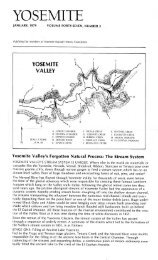
![(March 1982) [PDF] “We Are Pleased to Announce†- Yosemite Online](https://img.yumpu.com/51299748/1/190x242/march-1982-pdf-aeuroewe-are-pleased-to-announceaeur-yosemite-online.jpg?quality=85)
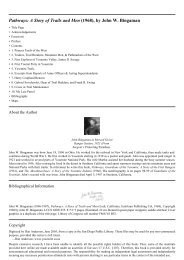
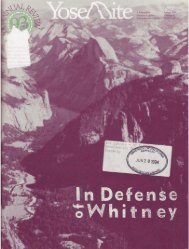
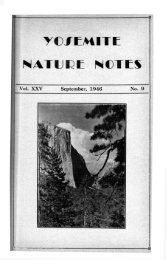
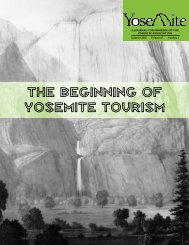
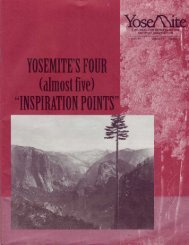
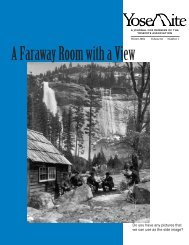
![1985 [PDF] - Yosemite](https://img.yumpu.com/48128837/1/184x260/1985-pdf-yosemite.jpg?quality=85)

